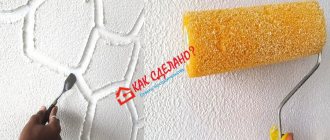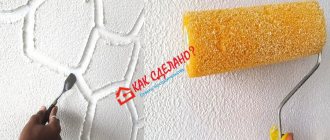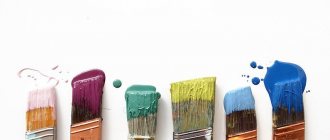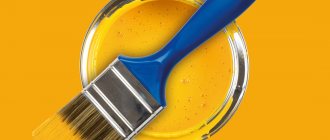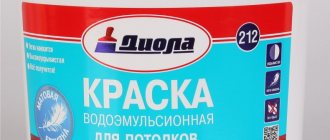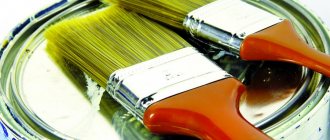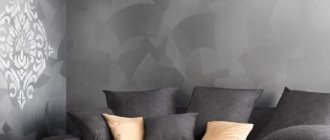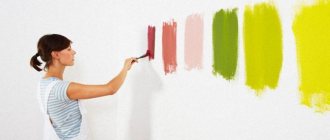Modern repair technologies help achieve original effects on various surfaces using a wide range of finishing materials. A popular finishing method is the use of textured paint in the interior. It is a liquid base to which various components, such as fillers and colors, are added as needed. In this article we will figure out how to apply textured wall paint with your own hands, its pros and cons.
Relief texture with different effects
There are many ways in which you can imitate the texture of natural materials, such as stone, leather or brick. In this article we will talk about the pros and cons of texture, properties and components, as well as the basic techniques for applying the composition.
Relief texture with different effects
Textured paints have become popular because they have a number of undeniable advantages:
- the coating hides minor wall defects and therefore does not require careful surface preparation;
- has high hardness (used as anti-vandal);
- water and weather resistant;
- vapor permeable - the walls will “breathe”;
- can be used on facades and for interior decoration.
Textured paint for walls: features and photo examples in the interior
Textured paint is a decorative coating based on acrylic and polymer components that give the surface a beautiful relief appearance. Its consistency is more like putty. Many formulations contain special additives that speed up the drying time of the layer to 1-2 hours.
The beautiful effect on the surface and the play of shadows appear in natural or artificial light. To apply it, you do not need to level the walls to perfection; it is enough to fill large uneven areas and then apply a textured effect.
Texture paint application methods
To obtain one or another texture, they resort to using different tools. This:
- Brush.
- Texture roller.
However, to achieve beautiful patterns, combs, sponges, a plastic bag or a trowel are used.
The brush application method is good when you need to treat a small area and hard-to-reach places on the surface. As for the roller, it is most convenient for them to work, especially on large and flat surfaces. But, since it will not paint the corners, they are painted over with a brush.
What types of textured paint are there for wall decoration?
To decorate walls, a wide variety of textures are used, which differ in composition, types of textures and color.
Types of textured paint for interior decoration
The main criterion for choosing textured paint is its base; therefore, finishing materials for interior work are classified into the following varieties.
| Type of texture | Description |
| Vinyl | Has excellent protection against external factors. |
| Acrylic | Water-based, has good plasticity, but is not resistant to ultraviolet radiation. |
| Silicate | The composition includes liquid glass, which protects against external influences. One of the disadvantages is the high consumption of material. |
| Silicone | It has excellent ductility and resistance to mechanical stress. |
| Mineral | It contains cement and has excellent vapor permeability and moisture resistance. For use in exterior finishing it is necessary to include additional additives. |
Before choosing a texture, you should study its properties
Characteristics of textured paint for exterior use
Textured paints are often used for finishing external surfaces; when choosing, you should pay attention to the manufacturer's recommendations on the packaging. They must have:
- waterproof;
- resistance to temperature changes.
Since the layer of texture is thicker, it will take longer to dry, so it is necessary to choose textures that contain special additives that speed up these processes.
The use of textured compositions for exterior finishing has its advantages: a relief coating does not require an ideal base, in addition, it will hide minor irregularities
What is texture painting and its features
Every person dreams of comfort in their own home. The atmosphere of comfort provides excellent mood to the inhabitants of the house. What is important here is a fashionable interior, tastefully selected, modern furniture, and above all, neat and high-quality repairs.
However, even the most exquisite splendor can fade in an apartment with uneven, crooked walls and ceilings. Unfortunately, this happens too often in old houses and new buildings, especially if they are panel. And there are plenty of reasons for such troubles: from negligence committed by builders to everyday problems.
But you don’t have to despair, it’s better to think about how to fix it! Eliminating deficiencies by leveling the house structure will take a lot of effort and time, especially since you need to have special skills to complete the task.
The optimal solution may be a skillfully done renovation using modern, high-quality textured paint. This will help create a visually smooth surface of ceilings and walls, give them the desired texture, provide decorative properties and significantly improve their performance characteristics.
Using texture paint you can easily hide uneven walls and ceilings
Traditional finishing methods: plastering followed by wallpapering, cladding with wood and plastic panels, used quite recently, are becoming a thing of the past.
And the list of techniques for decorative finishing is regularly updated. Glossy painting is used less and less in the usual ways, only emphasizing the curvature and imperfections of the walls. More preferable in this sense, matte paints and varnishes of old designs are also considered obsolete.
And the first place among the leaders in repairs is that it is capable of complementing the appearance of any surface with original fancy patterns and exquisite relief designs, textured paint for walls and ceilings. This is an extremely interesting decorative technique that exists today.
Such dyes include a whole group of materials created for textured finishing, having the consistency of a homogeneous, thick, creamy mass.
They are created on the basis of commonly used acrylic polymers, which have not only valuable properties for transforming the appearance of ceilings and walls, but also impressive practicality. These materials are capable of filling microcracks, skillfully masking the unevenness of the treated surfaces.
This family has certain characteristics and is one of the varieties of high-viscosity water-dispersion paints obtained through the use of special fillers.
The structural composition of the paint is supplemented with special microscopic particles. It is thanks to them that texture paint, when used, is endowed with the ability to create a relief coating on any surface: concrete, brick, and so on.
The paint, thanks to the acrylic binder included in its composition, can withstand significant temperature changes, creating an optimal level of humidity in the room being repaired.
An impressive variety of shades of dyes of this type is achieved by adding a pigment base in arbitrary proportions. Experimentation with the color palette is complemented by the use of a number of fillers created specifically for texture paint. They allow you to imitate a variety of surface textures.
All the pros and cons of textured wall paints
Textured paint is very popular because:
Advantages
- long service life without loss of original characteristics. With proper care, it will last at least 10 years;
- if necessary, you can update the coating, but there is no need to remove the old one;
- hypoallergenic and environmentally friendly;
- you can create a monolithic surface;
- easy maintenance, wet cleaning of the washable surface is allowed;
- versatility - suitable for both living rooms and kitchens.
Flaws
- texture consumption is 1,000 g/m²; when applying several layers, the cost of coating will be high. It is necessary to calculate the painting budget in advance;
- To obtain a high-quality result, leveling the base is required;
- To create an unusual effect, you need certain skills in applying plaster.
Manufacturers produce a huge variety of shades and textures, you can create unusual coatings and bring to life the most daring design solutions
Procurement of materials
Texture paint can be purchased at hardware stores in powder form. But it can also be a liquid mixture. If the paint is powder, then according to the instructions, dilute this mixture with water. Mix the contents tediously with an electric drill with a mixer attachment. In the case when you are using a liquid composition, it is enough to mix everything, because all the particles that give effects to the texture are constantly at the bottom of the vessel.
After all the mixing steps, the paint can be mixed with the selected color. This must be done carefully, add the mixture little by little, while constantly stirring. After you have added a certain amount of the mixture, you can use a piece of cardboard or plywood to check the tone and contrast of the paint to see if it matches what you want. Next we start painting the walls.
Decorative possibilities for painting walls with textured paints
Textured coatings are often used to decorate wall and ceiling surfaces in living rooms; they are also perfect for kitchens, corridors and loggias. All structures are classified into standard and coatings with unusual decorative effects.
Standard coating textures
Depending on the components of the textured paint, you can get a variety of decorative relief in the finish.
Mizuri - Composed of modified starch and acrylic components, the coating can have a smooth or wavy surface
Relief - Solid particles in the composition create the effect of bark beetle, smudges, waves, cracking
Marseille wax - The composition includes artificial wax components, thanks to which the structural coating, after drying, acquires the effect of an aged stone
Atacama - The surface has a rough structure thanks to quartz sand, special components give the finishing paint a metallic tint
Shagreen - The texture allows you to achieve uneven painting simulating concrete, metal or ordinary plaster. Outwardly, it resembles sandpaper or orange peel
Exquisite and unusual effects of textured wall paints
For interior decoration of wall surfaces, you can choose textures with an unusual effect.
Wet Silk - Cotton and cellulose fibers give an unusual velvet or silk effect
Mother of Pearl - Pearl shade fills the room with additional light. It is recommended to choose it for rooms with windows facing north - mother-of-pearl visually gives a feeling of warmth and comfort
An unusual effect is given to textured paint by the inclusion of quartz sand, shells or glitter, which creates a rough surface.
Mother-of-pearl dye adds dynamics to the room, creates a certain energy that increases efficiency. The matte finish has a calming effect; in addition, ultraviolet rays scatter when they hit it, thereby hiding minor imperfections in the finish.
Varieties and popular manufacturers
Texture paint is available in several types. They differ from each other in the components in their composition. Thanks to this, a textured surface is achieved.
- There are these types of texture paints:
- Paint and varnish material for external use.
- Structural paint for interior surface treatment.
- Universal compositions that are suitable for both indoor and outdoor work.
- Fine grain formulations.
- Texture paint with coarse grain fraction.
Advice! To decorate the ceiling or walls, you do not need to skimp on paint and varnish materials. It's better to pay more and get really high-quality coverage.
Before applying texture paint to the walls, it is better to consult with professionals who have been doing this work for many years. Ideally, try to treat the surface under their guidance in order to understand the principle and avoid mistakes.
The quality of the textured paint material plays a big role in application. We recommend choosing one of the brands provided below:
- "Tex Universal". Structural paint for walls, which is used for work outside and inside. It can be used to treat any walls in the house, even wet rooms such as the bathroom, kitchen and hallway. Thanks to its durable composition, a concrete or cement surface can be treated with just one layer. It will be enough to get a high-quality and durable coating.
- "Optimist". Acrylic-based textured paint material. Can also be used indoors and outdoors. Thanks to its good texture, the composition can even hide minor imperfections and surface defects.
It is worth noting that any water-dispersion paint can be made into a textured one by adding filler and other components inside.
Leading manufacturers of decorative textured paints
When choosing textured paints, you need to focus on the manufacturer, since unverified companies may produce a low-quality product, which will affect the finishing result. We can note well-known companies that offer inexpensive formulations with a variety of effects:
- Amourcolor paints are the most popular, they have increased durability and a variety of shades;
- "Lakra" is a Russian manufacturer that produces high-quality relief textures;
- the famous one offers compositions with imitation of aged surfaces, silk, velvet;
- the VGT brand from the Russian Federation produces textures adapted to our climatic conditions;
- "Blancolor" produces durable textures with imitation silk surfaces and waxed plaster.
Paint for textured plaster with a “wet silk” effect
DIY relief paint
Do-it-yourself texture paint is a popular question of interest to those who plan to paint a wall with a relief composition. The demand can be explained by the high cost of the material and the simple method of preparing a homemade suspension.
The manufacturing principle is to mix ordinary acrylic-based paint with a filler responsible for the relief. The main task in this situation is to find a suitable powdered substance. The easiest way out would be to purchase quartz sand or grind stone chips (granite, marble) into dust yourself. The grain size is selected individually according to your preferences. When preparing the mixture for painting indoor walls, try to ensure that it does not exceed 1-1.5 mm; for outdoor walls, larger fractions of up to 3 mm in size are allowed.
Procedure for working with structural paint Source kraski-net.ru
Drying structural paint for walls Source womanadvice.ru
Important! Do not try to use river or quarry sand as a filler, which is used on construction sites and in children's sandboxes. Its structure is not suitable for these purposes.
The average price tag for a bucket of acrylic texture paint with a volume of 18 liters is 2,500-2,700 rubles. The price of a regular acrylic composition in a 14 liter container is only 1,400-1,700 rubles. The difference in the financial component is obvious.
Important! Prices are taken in relation to the inexpensive Russian brand “Lakra”.
Creating a two-color surface Source gidpokraske.ru a.jpg
Which is the best textured paint to buy: recommendations for choosing
To avoid any unpleasant surprises when painting walls with textured paint, it is important to choose the right composition. To do this, you should first study the features of each type of coating and accurately determine the texture and desired shade.
Features of choosing washable textured paint for the walls of the kitchen, hallway and bathroom
For bathrooms, you should choose coatings that have increased moisture resistance. There is a high probability of contamination in the kitchen and hallway, so the main criterion is the possibility of wet cleaning. Having studied all the compositions, we can say that preference should be given to acrylic paint - it has excellent characteristics and a rich palette of shades. Using interesting application techniques you can achieve a unique visual effect.
Which textured paint is suitable for living rooms?
For the ceilings of living rooms, silicate textured paint is suitable, provided that the surface is first well leveled. The coating has a translucent structure and will highlight all defects. It should be applied in an even layer without additional relief; it is advisable to choose light shades. And for the walls you can choose a texture with an unusual effect, for example, velvet or wet silk.
Necessary tool
Decorating surfaces requires a certain skill. In addition to traditional painting tools, you can experiment with texture using available materials :
- crumpled foil;
- a twisted piece of rough fabric;
- coarse sponge;
- a bunch of plastic bags;
- fur attachment for the roller;
- coarse sandpaper;
- stencil or relief print;
- comb (wooden or rubber scraper, notched trowel);
- silicone or plastic mold for decorating the “stone”.
Before you start painting walls with a textured composition, prepare protective clothing and safety glasses. The room must be vacuumed, since abrasive particles from grinding reduce adhesion.
It is recommended to work using the tool indicated on the packaging of the decorative mixture. Otherwise, the standard set includes:
- spatula and trowel;
- roller with structural attachments;
- container for solution;
- construction mixer (drill with kneading attachment);
- a ditch for collecting paint with a roller.
To apply liquid compounds, it is suggested to use a paint spray gun. It will quickly and evenly distribute the texture dye over the surface of walls or ceilings.
Crinkled foil
Roller with fur attachment
Comb
Putty knife
Roller with a structured attachment
Paint cuvette Please note: Enamel XB-785
Textured paint for exterior finishing
For exterior decoration of buildings, you should choose textured paint, which includes special additives that increase the resistance of the coating to temperature changes, ultraviolet radiation and high humidity. Acrylic compositions fade in the sun, so it is better to avoid them, but vinyl mixtures are just suitable for painting facades. In addition, silicone and silicate textures can be used.
Do-it-yourself textured wall painting: tools and application technology
To apply textured paint with your own hands, brushes, sponges, and various rollers are most often used. During the work process, you should adhere to the same application technology throughout the entire room, otherwise the effect will not be so beautiful.
Roller application technique
Making relief with a sponge
Versatile brush application
Preparatory work before applying textured paint
Before applying textured paint with your own hands, you need to prepare the surfaces. The operating procedure is as follows.
- Lay the film on the floor and secure it to the ceiling with tape to prevent splashes during operation.
- Putty the walls, paying attention to deep cracks and irregularities.
- Coat the surface with an acrylic primer to improve adhesion of the paint to the base. For work it is better to use a roller; the composition should be applied evenly.
The surface is completely cleaned beforehand.
DIY methods for applying textured paint
Before painting walls with textured paint, you must prepare tools that will be used to create a relief to the surface:
- containers for water and paint;
- construction brushes with bristles of varying hardness;
- sponge;
- spatulas, trowels, construction floats;
- brush;
- rollers to create a rough base;
- trowel;
- overalls, glasses, gloves, cap.
The composition should be applied from top to bottom to avoid the formation of smudges. First of all, you should start working from those places that are poorly lit - this is a kind of training before processing the central zones.
Rollers with a textured base to give surface relief
Technique for applying textured paint with a roller and sponge
Let's look at the step-by-step process of applying textured paint for walls with a roller and sponge. First, the composition must be mixed well until it becomes a homogeneous mass.
- Apply white paint evenly onto the wall surface using a medium-nap roller. Drying time - 6-8 hours;
- Soak a natural sponge in cold water and squeeze well;
- Dip the sponge into the composition and apply it using tamponing movements over an area of 1-2 m². The work should take no more than 15 minutes, during which time the coating will dry out a little;
- Moisten the surface with water using a spray bottle;
- Smooth the sharp edges with a spatula using light movements;
- Then you can begin finishing the next section. You need to start from the upper left corner, gradually moving down and to the right. After 6-8 hours the surface will dry, excess protrusions can be removed using sandpaper;
- Wax is used for tinting. To facilitate its application, the surface is moistened with water from a spray bottle. The coating should be applied to an area of 0.5 m² using a brush. Remove excess wax with a spatula;
- The drying time of the decorative coating is 4-6 hours.
Step-by-step application of textured paint with a brush
Let's consider another way to apply a texture with a chameleon effect with a brush. To work, we need a composition in three shades.
- After mixing, the thick paint is applied to the wall using short multidirectional movements using a wide brush;
- The next day the wall is ready for further decoration;
- The remaining two tones must be mixed directly on the wall. To do this, use a brush to apply first one tone, then another, and blend with multidirectional movements on the surface;
- Upon visual inspection from different angles, all shades of the coating appear.
Why is additional processing needed?
After complete drying, you can apply interior varnish or wax to the surface - they will give the relief a more expressive structure. In addition, the additional coating has protective functions against mechanical damage.
Wax gives expressiveness
Advantages and disadvantages
Advantages:
- Resistance to high and low temperatures.
- Moisture resistance.
- Plasticity and elasticity, which makes it easy to apply paint and avoid cracks.
- Many texture paints contain antiseptic additives, which prevents mold from forming.
- Repels dust and dirt.
- Harmless to humans, as there are no harmful chemical impurities.
- Wide range of uses. There are structural paints for plastic, wood, stone, ceramics, concrete, metal and more.
- The ability to create any design and pattern.
- You can add coloring pigments to give the base the desired shade.
- Unusual appearance.
- Durability of operation – at least 10 years.
- High degree of strength - withstands any mechanical impact.
- Does not fade in the sun.
- Easy to care for.
- Unlike wallpaper, textured paints for ceilings and walls do not get dirty in places where they are frequently touched (switches, etc.).
- Surfaces coated with them “breathe”.
The disadvantages include significant consumption: per 1 sq. m. 1 kg of coloring agent is required.
Options for obtaining the required invoice
To obtain an unusual relief, there are various methods that use a variety of tools and devices.
- Brushes and brushes. This is the simplest option, allowing you to draw stripes that form patterns. Vertical, horizontal, diagonal and wavy directions are considered traditional, but you can show your imagination.
- Comb. Gives a similar result, but differs in more pronounced stripes. However, to obtain complex patterns you need to practice.
- Putty knife. This tool is used to create a rock relief that replicates natural rock. First you should choose the width of the blade: the smaller it is, the more complex the terrain. To apply the pattern, chaotic strokes are made with a spatula, after which the surface is slightly smoothed with a clean tool. A layer of tinting is placed on top.
For textured finishing, a special versatile tool is used - Simple roller. A foam coat leaves behind a fine-grained texture, while a fleece coat leaves behind stripes, the size and depth of which depends on the size of the hairs.
- Curly roller. The pattern is obtained from the drawing on the roller.
- Foam sponge. The walls are literally stamped with this device. The main thing is to avoid clear boundaries.
In general, any suitable materials and tools can be used for the job. Even with your hands you can create an interesting relief.
If desired, with simple tools you can create genuine masterpieces on the walls
Advice! It is recommended to test all created effects on a small area of plywood or cardboard, this will give you an idea of the final result.
General composition of coatings
Any type of paint and varnish material consists of the following components:
- Pigment;
- Solvent;
- Fillers;
- Supplements
Pigment gives paint its color. It is administered in the form of a fine powder. The intensity of the shade and the smoothness of the surface depend on the size of the granules.
In addition to the typical white tones, milky and beige enamels, as well as super white paints, are produced. The higher the degree of filtration of the dye from foreign impurities, the purer the shade obtained.
Additional components are used to create accelerated drying enamels with antibacterial protection and increased fire safety.
Benefits of white paint
The white shade in design is a universal color. It solves all problems with choosing colors in the interior. The light color fits perfectly into any style and is suitable for almost every material.
White color symbolizes purity and freshness. It is able to create a comfortable atmosphere in the room. Having many shades (beige, cotton shade, baked milk, mother-of-pearl) and different textures, white color, when properly combined, will help in creating unique color schemes in the room. And if you add a couple of bright details, the interior will not be boring, but memorable.
Designers often use white paint to paint walls and ceilings, as such materials help to visually increase the space of rooms. They create the effect of increased illumination, and in combination with other shades emphasize the main characteristics of decorative items.
Light materials in the living room will help create a cozy atmosphere and relax after working days. White color will save you from depression and bad mood. But at the same time, it is recommended to introduce bright decorative objects into the interior to create contrast against the background of plain walls. These could be colorful paintings or curtains.
The best manufacturers
On the construction market, the best range of white paint is offered by the following manufacturers:
- Slovenian.
- Finnish Tikkurila.
- Dulux company (Netherlands).
- Polish factory Sniezka.
- Dufa factory from Germany.
- Russian (trademarks “Texturol”, Parade, Krass).
This is not the entire list of factories and companies that produce the best paint and varnish products. But these are the main producers. Their paint is the purest white.
Working with white color is very interesting for both amateurs and professional designers. The white shade in the interior is multifaceted, beautiful and versatile. It creates an even atmosphere and brings a favorable mood.
But we must not forget about the disadvantages of such paint. Improperly organized work with white color can make a painted room boring and faceless. For the result of the work to be stunning, a serious approach followed by professional implementation is required!
